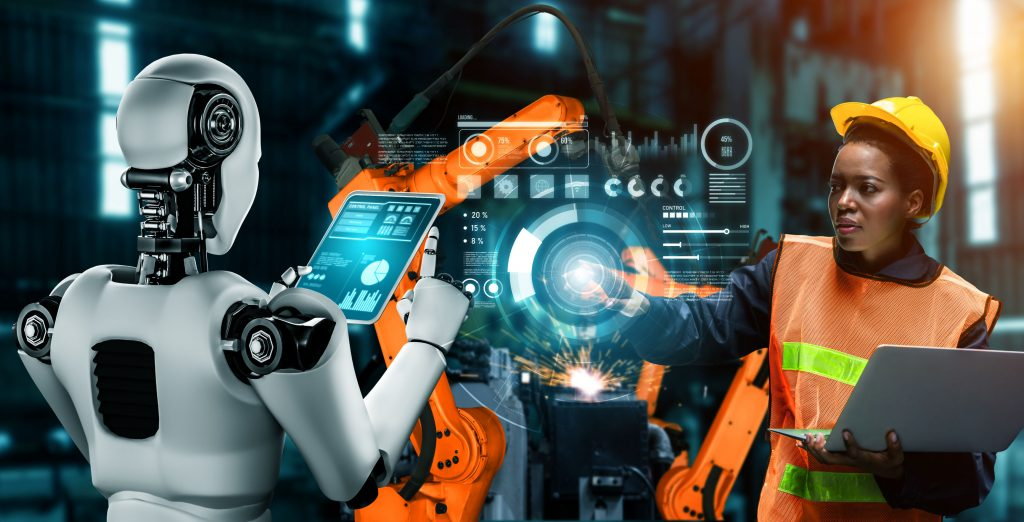The world is experiencing a significant transformation driven by advancements in robotics, with industries across the globe embracing these technologies to improve efficiency, productivity, and safety. Robotics is no longer confined to factory floors or manufacturing plants; it is expanding into various sectors, ranging from healthcare to agriculture, logistics, and even entertainment. As robotic technologies evolve, they are unlocking new possibilities, changing business models, and driving innovations that were once unimaginable. In this article, we explore how robotics is revolutionizing industries worldwide and the profound impacts it is having on the global economy.
Robotics in Manufacturing and Production
Enhancing Efficiency and Precision
One of the most well-known applications of robotics is in the manufacturing sector, where robots have been used for decades to automate repetitive and labor-intensive tasks. Today, robots in manufacturing are not just replacing manual labor; they are revolutionizing production lines by enhancing precision, speed, and efficiency.
Industrial robots in factories are capable of performing tasks such as assembly, welding, painting, packaging, and quality control with remarkable accuracy. They can work continuously without fatigue, leading to a significant increase in output and a reduction in human error. This has resulted in higher-quality products, reduced operational costs, and shorter production times.
For example, the automotive industry has long relied on robotics to streamline the production of vehicles. Automobile manufacturers such as Tesla and Toyota use robots for tasks ranging from welding car bodies to installing intricate electronic components. This has not only enhanced productivity but also improved safety by taking dangerous tasks away from human workers.
Customization and Flexibility in Production
Robots are also improving flexibility in manufacturing by allowing companies to produce customized products on a large scale. Traditional manufacturing systems are typically designed for mass production, making it difficult to produce individualized items without substantial cost and complexity. However, robots equipped with advanced programming and artificial intelligence (AI) can quickly adapt to new tasks, enabling manufacturers to produce smaller runs of customized products efficiently.
In industries such as electronics, consumer goods, and textiles, robots are being used to assemble, test, and package personalized products with minimal downtime between production batches. This flexibility allows companies to meet the growing demand for bespoke items while maintaining cost-effectiveness.
Robotics in Healthcare and Medicine
Revolutionizing Surgery and Medical Procedures
The healthcare industry is another sector that has seen a profound transformation due to robotics. Robotic surgery is becoming increasingly common, allowing for more precise, minimally invasive procedures. Surgeons use robotic systems like the da Vinci Surgical System to perform complex operations with greater control, smaller incisions, and less damage to surrounding tissues. This leads to faster recovery times, reduced risk of infection, and improved patient outcomes.
Robotic technologies also assist in tele-surgery, enabling specialists to perform surgeries remotely, regardless of distance, using advanced communication technologies. This is especially beneficial in regions with limited access to medical expertise, allowing patients in rural or underserved areas to benefit from cutting-edge medical procedures.
Advancing Diagnostics and Patient Care
In addition to surgery, robotics is improving healthcare by supporting diagnostics, patient monitoring, and rehabilitation. Robotic exoskeletons are helping individuals with mobility impairments regain some degree of independence, while robotic-assisted rehabilitation devices provide patients with tailored therapy, improving recovery after injuries or strokes.
Additionally, robots equipped with AI can assist doctors in diagnosing diseases. For example, AI-powered diagnostic robots can analyze medical images such as X-rays or MRIs to detect abnormalities like tumors with greater accuracy than human radiologists. This improves the speed and accuracy of diagnoses, ensuring that patients receive timely treatment.
Robotics in Agriculture
Automating Farming Tasks
Agriculture, a vital sector for the global economy, is also undergoing a revolution with the advent of robotics. Agricultural robots, or agribots, are being employed to automate tasks like planting, watering, harvesting, and weeding. These robots help farmers address labor shortages, reduce costs, and increase crop yields.
For instance, robots like the see & spray technology developed by John Deere can identify and target weeds with precision, applying herbicides only where necessary. This reduces the use of chemicals and minimizes environmental impact, contributing to more sustainable farming practices. Similarly, automated harvesting robots are designed to pick fruits like strawberries or apples, reducing the reliance on manual labor and increasing harvesting speed.
Enhancing Sustainability and Precision Agriculture
Robotics is also playing a crucial role in the development of precision agriculture, which uses data and technology to optimize farming processes. Robots, when paired with drones and sensors, allow farmers to monitor crop health, soil moisture levels, and pest infestations in real-time. This data-driven approach enables more efficient use of resources such as water, fertilizers, and pesticides, contributing to sustainable farming practices.
Through precise measurements and automation, robots can help minimize waste, reduce environmental impact, and increase the overall sustainability of farming. These innovations are essential in addressing the challenges posed by climate change, growing populations, and the need for sustainable food production.
Robotics in Logistics and Supply Chain Management
Transforming Warehouses and Distribution Centers
The logistics and supply chain industry has been greatly impacted by the rise of robotics. Automated guided vehicles (AGVs) and robotic arms are now being used in warehouses and distribution centers to move goods, sort packages, and pick items for shipment. This automation reduces human labor, speeds up processes, and enhances inventory management.
Companies like Amazon and Alibaba have already implemented sophisticated robotic systems in their fulfillment centers to streamline order picking and packing. Amazon, for instance, uses robots such as the Kiva system to transport items across the warehouse floor, enabling faster delivery times and reducing operational costs. These robots can work around the clock, significantly improving the speed and efficiency of warehouse operations.
Improving Last-Mile Delivery
In addition to warehouse automation, robots are also transforming the last-mile delivery process. Drones and autonomous vehicles are now being used to deliver goods directly to consumers, eliminating the need for human delivery drivers in some cases. Companies such as Wing, a subsidiary of Alphabet (Google’s parent company), are testing drone deliveries in select areas, allowing customers to receive packages within minutes of placing an order.
These developments are reshaping the logistics landscape by improving delivery times, reducing costs, and increasing efficiency. As technology advances, it is expected that robotics will continue to play an even greater role in streamlining logistics and supply chains, especially as e-commerce continues to grow.
Robotics in Retail and Customer Service
Enhancing the In-Store Experience
Robotics is also making its mark in the retail sector, where robots are used for a variety of tasks, including stocking shelves, assisting customers, and even processing transactions. Robotic assistants in stores are capable of guiding customers, answering questions, and helping them find specific products. For example, the Pepper robot, developed by SoftBank Robotics, is already being used in several stores and shopping centers to provide information and engage with customers.
Additionally, robots are improving the efficiency of inventory management by autonomously scanning shelves and tracking product levels, reducing the likelihood of stockouts and ensuring that shelves are always stocked with popular items. This is particularly useful in large stores where manual inventory checks can be time-consuming and error-prone.
Revolutionizing Customer Service
In customer service, chatbots and virtual assistants, powered by AI and robotics, are becoming increasingly common. These automated systems are capable of handling customer inquiries, processing orders, and solving problems with minimal human intervention. This not only improves response times but also ensures that customers receive consistent and accurate information around the clock.
The Future of Robotics Across Industries
Artificial Intelligence and Machine Learning Integration
As robotics continues to evolve, its integration with artificial intelligence (AI) and machine learning (ML) is opening up new possibilities. AI-enabled robots can now learn from their environments, adapt to new tasks, and make real-time decisions based on data. This enhanced autonomy allows robots to perform complex tasks that were once considered too challenging for automation.
The combination of robotics, AI, and ML is leading to the creation of more intelligent, flexible systems that can perform tasks in a variety of unpredictable environments. This trend is expected to accelerate, with robots becoming more adaptable, versatile, and capable of operating in sectors that were previously difficult to automate.
Ethical and Economic Implications
As robotics continues to revolutionize industries, it raises important ethical and economic considerations. The widespread adoption of robots could lead to job displacement in certain sectors, particularly in industries that rely on manual labor. While robots are creating new jobs in fields like robotics design and programming, it is crucial to consider how societies can manage these shifts and ensure that workers have access to retraining and upskilling opportunities.
Moreover, the ethical implications of using robots in sensitive fields like healthcare and military applications raise important questions about safety, accountability, and privacy. As robots become more integrated into various industries, it is essential to establish ethical guidelines and regulatory frameworks to ensure their responsible use.
Conclusion
Robotics is no longer a futuristic concept; it is a present-day reality that is transforming industries across the globe. From enhancing manufacturing efficiency to revolutionizing healthcare, agriculture, and logistics, robots are playing a central role in driving innovation, productivity, and sustainability. As technology continues to evolve, we can expect even greater advancements, allowing robots to become increasingly autonomous and versatile across various sectors. However, the widespread adoption of robotics also presents challenges that require careful consideration, particularly in terms of ethical concerns and workforce implications. Despite these challenges, the continued integration of robotics into industries will undoubtedly reshape the way businesses operate and revolutionize our daily lives.

